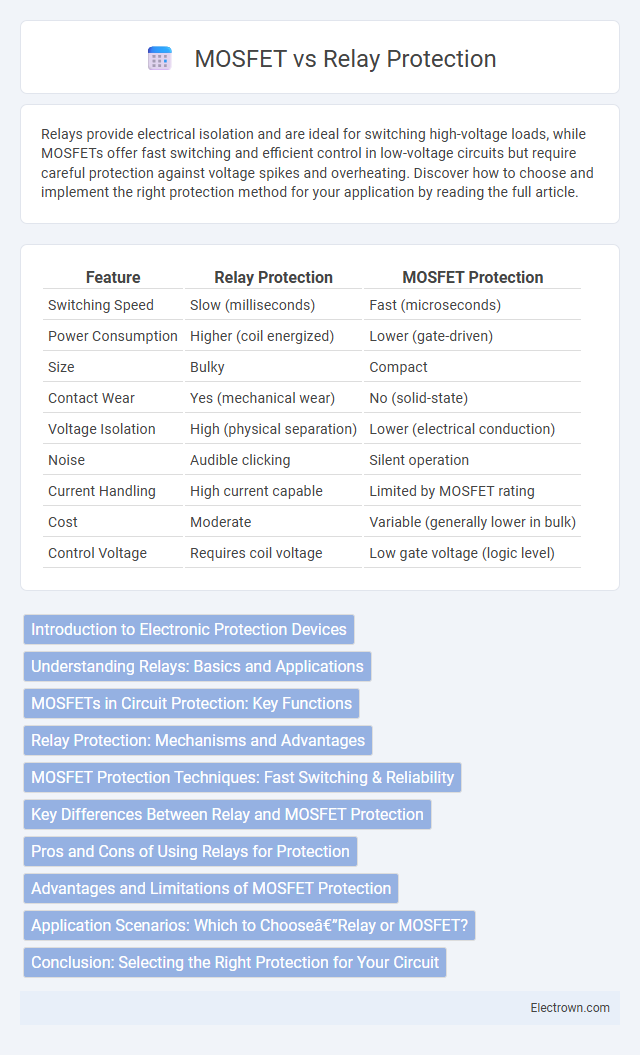Relays provide electrical isolation and are ideal for switching high-voltage loads, while MOSFETs offer fast switching and efficient control in low-voltage circuits but require careful protection against voltage spikes and overheating. Discover how to choose and implement the right protection method for your application by reading the full article.
Table of Comparison
| Feature | Relay Protection | MOSFET Protection |
|---|---|---|
| Switching Speed | Slow (milliseconds) | Fast (microseconds) |
| Power Consumption | Higher (coil energized) | Lower (gate-driven) |
| Size | Bulky | Compact |
| Contact Wear | Yes (mechanical wear) | No (solid-state) |
| Voltage Isolation | High (physical separation) | Lower (electrical conduction) |
| Noise | Audible clicking | Silent operation |
| Current Handling | High current capable | Limited by MOSFET rating |
| Cost | Moderate | Variable (generally lower in bulk) |
| Control Voltage | Requires coil voltage | Low gate voltage (logic level) |
Introduction to Electronic Protection Devices
Electronic protection devices like relays and MOSFETs serve critical roles in safeguarding circuits from overloads, short circuits, and faults. Relays provide mechanical isolation and can handle high voltages and currents, making them reliable for switching heavy loads, while MOSFETs offer fast, efficient semiconductor-based switching with low power loss and precise control. Understanding the distinct advantages of relay versus MOSFET protection helps you optimize your electronic design for safety, speed, and efficiency.
Understanding Relays: Basics and Applications
Relays are electromechanical switches that use an electromagnetic coil to open or close contacts, allowing control of high-power circuits with low-power signals. Their applications span automotive systems, industrial automation, and home appliances, providing reliable isolation between control and load circuits. Compared to MOSFETs, relays excel in handling high voltage and current loads with mechanical durability but operate slower and consume more power.
MOSFETs in Circuit Protection: Key Functions
MOSFETs in circuit protection primarily function as fast-switching devices that enable precise control over current flow, minimizing damage from overcurrent or short circuits. Their low on-resistance and rapid response times improve efficiency and reduce heat dissipation compared to traditional relays. Integrated protection features such as threshold voltage control and thermal shutdown make MOSFETs ideal for safeguarding sensitive electronic components in modern circuits.
Relay Protection: Mechanisms and Advantages
Relay protection employs electromagnetic switches to isolate circuits during faults, providing reliable and complete disconnection that safeguards sensitive components from overcurrent and voltage spikes. Its mechanical design offers galvanic isolation, enhancing safety by preventing electrical noise and transient disturbances from affecting the protected system. You benefit from relays' robustness in high-voltage environments and their ability to handle large current loads without signal degradation.
MOSFET Protection Techniques: Fast Switching & Reliability
MOSFET protection techniques enhance fast switching and reliability by incorporating gate drivers with built-in fault detection and using snubber circuits to minimize voltage spikes. Employing transient voltage suppressors (TVS) and proper gate resistor sizing prevents overvoltage and reduces switching losses, ensuring your MOSFET operates efficiently under rapid switching conditions. These strategies improve overall device durability and maintain stable performance in high-speed electronic applications.
Key Differences Between Relay and MOSFET Protection
Relay protection uses electromechanical switches to isolate circuits, providing physical disconnection and high voltage isolation, while MOSFET protection relies on solid-state switching with faster response times and lower power loss. Relays offer reliable operation in high-current environments but tend to be slower and bulkier, whereas MOSFETs enable compact designs with precise electronic control, suitable for sensitive and high-frequency applications. Your choice depends on factors like switching speed, durability, power efficiency, and circuit complexity.
Pros and Cons of Using Relays for Protection
Relays offer galvanic isolation and can switch high voltages and currents, making them ideal for protecting sensitive electronic circuits from overloads and faults. However, their mechanical nature leads to slower switching speeds, limited lifespan due to contact wear, and higher power consumption compared to solid-state devices like MOSFETs. Despite these drawbacks, relays remain advantageous in applications requiring complete electrical isolation and robustness against voltage spikes.
Advantages and Limitations of MOSFET Protection
MOSFET protection offers faster switching speeds and lower on-resistance compared to relays, resulting in improved efficiency and reduced power loss in your circuits. Its solid-state nature eliminates mechanical wear, enhancing reliability and lifespan, though MOSFETs can be more sensitive to voltage spikes and require careful gate drive design. Limitations include higher complexity and cost compared to simple relay protection, but MOSFETs excel in applications demanding rapid response and precise control.
Application Scenarios: Which to Choose—Relay or MOSFET?
Relay protection works best in high-voltage, high-current applications where electrical isolation is critical, such as in industrial machinery or HVAC systems. MOSFET protection excels in low-voltage, fast-switching environments like battery management systems and DC/DC converters due to its efficient, solid-state design and longer lifespan. Your choice depends on whether you prioritize mechanical robustness and isolation (relay) or speed and durability in electronic circuits (MOSFET).
Conclusion: Selecting the Right Protection for Your Circuit
Choosing the right protection device depends on your circuit's requirements for switching speed, current capacity, and durability. MOSFETs offer faster response times, higher efficiency, and longer lifespan in solid-state protection, while relays provide electrical isolation and are better suited for high-voltage or inductive loads. Evaluate your application's voltage, current, and environmental conditions to determine whether a MOSFET or relay will best safeguard your system's performance and reliability.
relay vs mosfet protection Infographic

 electrown.com
electrown.com